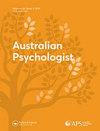在COVID-19大流行之前和期间,参加全校范围在线心理健康促进干预的学生的心理健康波动
IF 2
4区 心理学
Q2 PSYCHOLOGY, MULTIDISCIPLINARY
引用次数: 0
摘要
摘要目的越来越多的证据表明,针对大学生的在线心理健康干预是解决大学生心理健康问题的一种具有成本效益的手段。这项研究提供了在新冠肺炎大流行前后,在大学范围内推广该项目的背景下,参与名为YOLO的在线心理健康促进干预的学生人数和特征的数据。方法参与者完成了一份评估社会人口统计和心理健康(幸福和痛苦)的问卷。在12个月的时间里,共有240名学生参加了该项目,其中164人提供了可靠的数据。结果代表不同社会形态的学生访问YOLO,包括国内和国际学生状况、学位水平、教师、种族和年龄,尽管女性的比例过高(77.2%)。在COVID-19之前访问YOLO的学生在大多数心理健康维度上与在COVIDVID-19期间访问的学生没有显著差异,尽管在新冠肺炎期间报告轻度-中度焦虑症状的学生比新冠肺炎前多。唯一与心理健康显著相关的社会人口统计数据是年龄和学位水平。年龄较小与焦虑程度较高有关,与其他年份的学生相比,三年级和四年级本科生的心理健康状况较差。此外,这些学生在新冠肺炎期间获得YOLO的比例高于新冠肺炎前。结论目前的数据以及其他评估YOLO的研究结果表明,不需要面对面接触的在线心理健康促进计划是所有大学生的重要和必要的资源。关键点关于这个话题已经知道的是:(1)大学生报告说他们有高度的精神困扰。(2) 大学往往缺乏向所有学生提供支持的能力。(3) 在线心理健康项目可能是提供支持的宝贵工具。该主题补充道:(1)大学生自我报告的心理困扰在新冠肺炎前和期间没有显著增加,但三年级和四年级学生报告的心理折磨在新冠肺炎期间最多。(2) YOLO项目被不同文化背景、年龄、入学状态和学科的学生使用。(3) YOLO在线项目可能是大学可以用来支持学生心理健康的一个有用项目。本文章由计算机程序翻译,如有差异,请以英文原文为准。
Fluctuations in mental health in students accessing a university-wide online mental health promotion intervention before and during the COVID-19 pandemic
ABSTRACT Objective Growing evidence shows that online mental health interventions for university students are a cost-effective means for addressing mental health problems among university students. This study presents data on the numbers and characteristics of students who engaged in an online mental health promotion intervention called YOLO in the context of a university-wide rollout of the program before and after the onset of the COVID-19 pandemic. Methods Participants completed a questionnaire assessing socio-demographics and mental health (wellbeing and distress). A total of 240 students accessed the program over a 12-month period and of these, 164 provided reliable data. Results YOLO was accessed by students representing diverse socio-demographics including domestic vs. international student status, degree level, faculty, ethnicity, and age, although there was an over-representation of females (77.2%). Students who accessed YOLO pre-COVID-19 did not substantially differ across most mental health dimensions from those who accessed it during-COVID-19, although more students reported mild-moderate anxiety symptoms during-COVID than pre-COVID-19. The only socio-demographics significantly associated with mental health were age and degree level. Younger age was related to higher anxiety and 3rd and 4th year undergraduate students reported poorer mental health comparative to students in other years. Additionally, a higher proportion of these students accessed YOLO during-COVID-19 than at pre-COVID-19. Conclusion The present data along with findings from other studies that have evaluated YOLO, suggest that online mental health promotion programs that do not require in-person contact are an important and necessary resource for all university students. KEY POINTS What is already known about this topic: (1) University students report high levels of mental distress. (2) Universities often lack capacity to provide support to all students. (3) Online, mental health programs may be a valuable tool to provide support. What this topic adds: (1) University students’ self-reported psychological distress did not increase significantly pre and during COVID-19, however third-year and fourth-year students reported the most psychological distress during COVID-19. (2) The YOLO program was used by students of multiple cultural backgrounds, ages, enrolment statuses, and disciplines. (3) The YOLO online program may be one useful program Universities can use to support students’ psychological wellbeing.
求助全文
通过发布文献求助,成功后即可免费获取论文全文。
去求助
来源期刊

Australian Psychologist
PSYCHOLOGY, MULTIDISCIPLINARY-
CiteScore
3.70
自引率
5.30%
发文量
32
期刊介绍:
The Australian Psychologist is the official applied practice and public policy journal of the Australian Psychological Society. As such, the journal solicits articles covering current issues in psychology, the science and practice of psychology, and psychology"s contribution to public policy, with particular emphasis on the Australian context. Periodically, Australian Psychological Society documents, including but not limited to, position papers, reports of the Society, ethics information, surveys of the membership, announcements, and selected award addresses may appear in the journal.
 求助内容:
求助内容: 应助结果提醒方式:
应助结果提醒方式:


